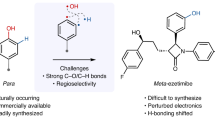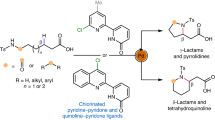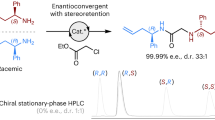Abstract
C–H activation has been recognized as an increasingly viable tool in molecular sciences, but organometallic C–C activation is scarce, and limited to precious and toxic metal catalysts. Herein, we disclose versatile C–C activations by a robust base-metal catalyst in water. Thus, an inexpensive manganese(i) catalyst enabled C–C functionalizations with excellent levels of chemo- and position-selectivities, setting the stage for versatile C–C allylations, C–C alkenylations and C–C alkylations in water. The manganese(i) catalyst outperformed commonly used copper, iron, palladium, rhodium and ruthenium complexes, and the C–C activations occurred on steroid and amino acid motifs. Detailed kinetic and computational studies provided strong support for a kinetically relevant C–C manganesation.
This is a preview of subscription content, access via your institution
Access options
Access Nature and 54 other Nature Portfolio journals
Get Nature+, our best-value online-access subscription
$29.99 / 30 days
cancel any time
Subscribe to this journal
Receive 12 digital issues and online access to articles
$119.00 per year
only $9.92 per issue
Buy this article
- Purchase on Springer Link
- Instant access to full article PDF
Prices may be subject to local taxes which are calculated during checkout








Similar content being viewed by others
Data availability
The X-ray crystallographic coordinates for the structure of compound C’ have been deposited at the Cambridge Crystallographic Data Centre (CCDC), under deposition number 1871580. These data can be obtained free of charge from The Cambridge Crystallographic Data Centre via www.ccdc.cam.ac.uk/data_request/cif. All data is also available from the authors upon reasonable request.
References
Davies, H. M. L. & Manning, J. R. Catalytic C–H functionalization by metal carbenoid and nitrenoid insertion. Nature 451, 417–424 (2008).
Bergman, R. G. Organometallic chemistry: C–H activation. Nature 446, 391–393 (2007).
Gandeepan, P. & Ackermann, L. Transient directing groups for transformative C–H activation by synergistic metal catalysis. Chem 4, 199–222 (2018).
He, J., Wasa, M., Chan, K. S. L., Shao, Q. & Yu, J.-Q. Palladium-catalyzed transformations of alkyl C–H bonds. Chem. Rev. 117, 8754–8786 (2017).
Fumagalli, G., Stanton, S. & Bower, J. F. Recent methodologies that exploit C–C single-bond cleavage of strained ring systems by transition metal complexes. Chem. Rev. 117, 9404–9432 (2017).
Chen, P. H., Billett, B. A., Tsukamoto, T. & Dong, G. “Cut and sew” transformations via transition-metal-catalyzed carbon–carbon bond activation. ACS Catal. 7, 1340–1360 (2017).
Murakami, M. & Ishida, N. Potential of metal-catalyzed C–C single bond cleavage for organic synthesis. J. Am. Chem. Soc. 138, 13759–13769 (2016).
Nairoukh, Z., Cormier, M. & Marek, I. Merging C–H and C–C bond cleavage in organic synthesis. Nat. Rev. Chem. 1, 0035 (2017).
Souillart, L. & Cramer, N. Catalytic C–C bond activations via oxidative addition to transition metals. Chem. Rev. 115, 9410–9464 (2015).
Chen, F., Wang, T. & Jiao, N. Recent advances in transition-metal-catalyzed functionalization of unstrained carbon–carbon bonds. Chem. Rev. 114, 8613–8661 (2014).
Murakami, M. & Matsuda, T. Metal-catalysed cleavage of carbon–carbon bonds. Chem. Commun. 47, 1100–1105 (2011).
Jun, C.-H. Transition metal-catalyzed carbon–carbon bond activation. Chem. Soc. Rev. 33, 610–618 (2004).
Okumura, S., Sun, F., Ishida, N. & Murakami, M. Palladium-catalyzed intermolecular exchange between C–C and C–Si σ-bonds. J. Am. Chem. Soc. 139, 12414–12417 (2017).
Ishida, N., Sawano, S. & Murakami, M. Stereospecific ring expansion from orthocyclophanes with central chirality to metacyclophanes with planar chirality. Nat. Commun. 5, 3111 (2014).
Murakami, M., Ashida, S. & Matsuda, T. Nickel-catalyzed intermolecular alkyne insertion into cyclobutanones. J. Am. Chem. Soc. 127, 6932–6933 (2005).
Murakami, M., Amii, H., Shigeto, K. & Ito, Y. Breaking of the C–C bond of cyclobutanones by rhodium(i) and its extension to catalytic synthetic reactions. J. Am. Chem. Soc. 118, 8285–8290 (1996).
Murakami, M., Amii, H. & Ito, Y. Selective activation of carbon–carbon bonds next to a carbonyl group. Nature 370, 540–541 (1994).
Wang, G. W., McCreanor, N. G., Shaw, M. H., Whittingham, W. G. & Bower, J. F. New initiation modes for directed carbonylative C–C bond activation: rhodium-catalyzed (3 + 1 + 2) cycloadditions of aminomethylcyclopropanes. J. Am. Chem. Soc. 138, 13501–13504 (2016).
Shaw, M. H., Melikhova, E. Y., Kloer, D. P., Whittingham, W. G. & Bower, J. F. Directing group enhanced carbonylative ring expansions of amino-substituted cyclopropanes: rhodium-catalyzed multicomponent synthesis of N-heterobicyclic enones. J. Am. Chem. Soc. 135, 4992–4995 (2013).
Xia, Y., Lu, G., Liu, P. & Dong, G. Catalytic activation of carbon–carbon bonds in cyclopentanones. Nature 539, 546–550 (2016).
Deng, L., Xu, T., Li, H. & Dong, G. Enantioselective Rh-catalyzed carboacylation of C═N bonds via C–C activation of benzocyclobutenones. J. Am. Chem. Soc. 138, 369–374 (2016).
Xu, T. & Dong, G. Rhodium-catalyzed regioselective carboacylation of olefins: a C–C bond activation approach for accessing fused-ring systems. Angew. Chem. Int. Ed. 51, 7567–7571 (2012).
Ozkal, E., Cacherat, B. & Morandi, B. Cobalt(iii)-catalyzed functionalization of unstrained carbon–carbon bonds through β-carbon cleavage of alcohols. ACS Catal. 5, 6458–6462 (2015).
Yoichiro, K., Tadamasa, U., Atsushi, K. & Kazuhiko, T. Manganese-catalyzed cleavage of a carbon–carbon single bond between carbonyl carbon and α-carbon atoms of ketones. Angew. Chem. Int. Ed. 50, 10406–10408 (2011).
Yasunori, M., Hirofumi, Y., Yoshiaki, N. & Tamejiro, H. Highly chemoselective carbon–carbon σ-bond activation: nickel/Lewis acid catalyzed polyfluoroarylcyanation of alkynes. Angew. Chem. Int. Ed. 52, 883–887 (2013).
Masahiro, S., Hideki, Y. & Koichiro, O. Allyl-, allenyl-, and propargyl-transfer reactions through cleavage of C–C bonds catalyzed by an N-heterocyclic carbene/copper complex: synthesis of multisubstituted pyrroles. Angew. Chem. Int. Ed. 50, 3294–3298 (2011).
Lei, Z.-Q. et al. Extrusion of CO from aryl ketones: rhodium(i)-catalyzed C–C bond cleavage directed by a pyridine group. Angew. Chem. Int. Ed. 51, 2690–2694 (2012).
Li, H. et al. Pyridinyl directed alkenylation with olefins via Rh(iii)-catalyzed C–C bond cleavage of secondary arylmethanols. J. Am. Chem. Soc. 133, 15244–15247 (2011).
Gooßen, L. J., Deng, G. & Levy, L. M. Synthesis of biaryls via catalytic decarboxzlative coupling. Science 313, 662–664 (2006).
Okazawa, T., Satoh, T., Miura, M. & Nomura, M. Palladium-catalyzed multiple arylation of thiophenes. J. Am. Chem. Soc. 124, 5286–5287 (2002).
Egorova, K. S. & Ananikov, V. P. Which metals are green for catalysis? Comparison of the toxicities of Ni, Cu, Fe, Pd, Pt, Rh, and Au salts. Angew. Chem. Int. Ed. 55, 12150–12162 (2016).
Moselage, M., Li, J., Kramm, F. & Ackermann, L. Ruthenium(ii)-catalyzed C–C arylations and alkylations: decarbamoylative C–C functionalizations. Angew. Chem. Int. Ed. 56, 5341–5344 (2017).
Kumar, N. Y. P., Bechtoldt, A., Raghuvanshi, K. & Ackermann, L. Ruthenium(ii)-catalyzed decarboxylative C–H activation: versatile routes to meta-alkenylated arenes. Angew. Chem. Int. Ed. 55, 6929–6932 (2016).
Egorova, K. S. & Ananikov, V. P. Toxicity of metal compounds: knowledge and myths. Organometallics 36, 4071–4090 (2017).
Cahiez, G., Duplais, C. & Buendia, J. Chemistry of organomanganese(ii) compounds. Chem. Rev. 109, 1434–1476 (2009).
Zhou, B., Chen, H. & Wang, C. Mn-catalyzed aromatic C–H alkenylation with terminal alkynes. J. Am. Chem. Soc. 135, 1264–1267 (2013).
Lu, Q., Klauck, F. J. R. & Glorius, F. Manganese-catalyzed allylation via sequential C–H and C–C/C–Het bond activation. Chem. Sci. 8, 3379–3383 (2017).
Liu, W. & Ackermann, L. Manganese-catalyzed C–H activation. ACS Catal. 6, 3743–3752 (2016).
Wang, C. Manganese-mediated C–C bond formation via C–H activation: from stoichiometry to catalysis. Synlett. 24, 1606–1613 (2013).
Wang, H., Lorion, M. M. & Ackermann, L. Air-stable manganese(i)-catalyzed C–H activation for decarboxylative C–H/C–O cleavages in water. Angew. Chem. Int. Ed. 56, 6339–6342 (2017).
Zhou, B., Hu, Y., Liu, T. & Wang, C. Aromatic C–H addition of ketones to imines enabled by manganese catalysis. Nat. Commun. 8, 1169 (2017).
Butler, R. N. & Coyne, A. G. Water: nature’s reaction enforcer–comparative effects for organic synthesis “in-water” and “on-water”. Chem. Rev. 110, 6302–6337 (2010).
Adamo, C. & Barone, V. Toward reliable density functional methods without adjustable parameters: the PBE0 model. J. Chem. Phys. 110, 6158–6170 (1999).
Grimme, S., Antony, J., Ehrlich, S. & Krieg, H. A consistent and accurate ab initio parametrization of density functional dispersion correction (DFT-D) for the 94 elements H-Pu. J. Chem. Phys. 132, 154104 (2010).
Grimme, S., Ehrlich, S. & Goerigk, L. Effect of the damping function in dispersion corrected density functional theory. J. Comput. Chem. 32, 1456–1465 (2011).
Weigend, F. & Ahlrichs, R. Balanced basis sets of split valence, triple zeta valence and quadruple zeta valence quality for H to Rn: design and assessment of accuracy. Phys. Chem. Chem. Phys. 7, 3297–3305 (2005).
Marenich, A. V., Cramer, C. J. & Truhlar, D. G. Universal solvation model based on solute electron density and on a continuum model of the solvent defined by the bulk dielectric constant and atomic surface tensions. J. Chem. Phys. B 113, 6378–6396 (2009).
Kozuch, S. & Shaik, S. How to conceptualize catalytic cycles? The energetic span model. Acc. Chem. Res. 44, 101–110 (2011).
Boda, M. & Naresh Patwari, G. Insights into acid dissociation of HCl and HBr with internal electric fields. Phys. Chem. Chem. Phys. 19, 7461–7464 (2017).
Blakemore, D. C. et al. Organic synthesis provides opportunities to transform drug discovery. Nat. Chem. 10, 383–394 (2018).
Acknowledgements
Generous support by the DFG (SPP 1807), the CSC (fellowship to H.W.), the KEF (fellowship to I.C.) and the Onassis Foundation (fellowship to N.K.) is gratefully acknowledged. We also thank C. Golz (Göttingen University) for the X-ray diffraction analysis.
Author information
Authors and Affiliations
Contributions
H.W. developed the manganese-catalysed C–C activation. H.W., I.C. and N.K. identified the substrate scope. H.W., I.C. and T.R. conducted the mechanistic investigations. T.R. performed the computational studies. L.A. conceived and supervised the project. L.A. prepared the manuscript.
Corresponding author
Ethics declarations
Competing interests
The authors declare no competing interests.
Additional information
Publisher’s note: Springer Nature remains neutral with regard to jurisdictional claims in published maps and institutional affiliations.
Supplementary information
Supplementary Information
Supplementary Methods, Supplementary Tables 1–4, Supplementary Figures 1–6, Supplementary References
Supplementary Data 1
Cartesian coordinates and energies
Compound C′
Crystallographic data for compound C′
Rights and permissions
About this article
Cite this article
Wang, H., Choi, I., Rogge, T. et al. Versatile and robust C–C activation by chelation-assisted manganese catalysis. Nat Catal 1, 993–1001 (2018). https://doi.org/10.1038/s41929-018-0187-1
Received:
Accepted:
Published:
Issue Date:
DOI: https://doi.org/10.1038/s41929-018-0187-1
This article is cited by
-
Cobalt-catalyzed divergent functionalization of N-sulfonyl amines via β-carbon elimination
Science China Chemistry (2022)
-
Orthogonal cross-coupling through intermolecular metathesis of unstrained C(aryl)–C(aryl) single bonds
Nature Chemistry (2021)
-
Temporary or removable directing groups enable activation of unstrained C–C bonds
Nature Reviews Chemistry (2020)
-
Development of a practical non-noble metal catalyst for hydrogenation of N-heteroarenes
Nature Catalysis (2020)
-
Late-stage peptide C–H alkylation for bioorthogonal C–H activation featuring solid phase peptide synthesis
Nature Communications (2019)



